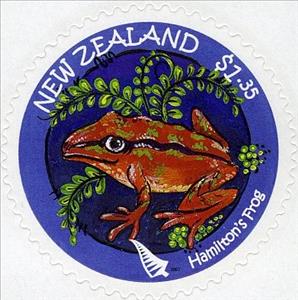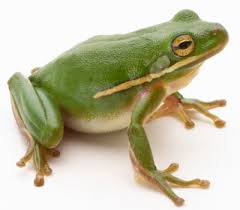Stamp: Hamilton's Frog (New Zealand 2007)
Hamilton's Frog (New Zealand 2007)
07 March (New Zealand ) within release Native Wildlife goes into circulation Stamp Hamilton's Frog face value 1.35 New Zealand dollar
| Stamp Hamilton's Frog in catalogues | |
|---|---|
| Stanley Gibbons: | Sg:NZ 2938 |
Stamp is square format.
CIRCULAR SELF-ADHESIVEAlso in the issue Native Wildlife:
- Stamp - Tuatara face value 45;
- Stamp - Kiwi face value 90;
- Stamp - Hamilton's Frog face value 1.35;
- Stamp - Yellow Eyed Penguin face value 1.50;
- Stamp - Hector's Dolphin face value 2;
- Se-tenant - Native Wildlife strip face value 6.20;
|
Data entry completed
53%
|
|
|---|---|
| Stamp Hamilton's Frog in digits | |
| Country: | New Zealand |
| Date: | 2007-03-07 |
| Perforation: | comb 11½ |
| Format: | Stamp |
| Face Value: | 1.35 New Zealand dollar |
Stamp Hamilton's Frog it reflects the thematic directions:
A frog is any member of a diverse and largely carnivorous group of short-bodied, tailless amphibians composing the order Anura[(coming from the Ancient Greek ἀνούρα, literally 'without tail'). The oldest fossil "proto-frog" Triadobatrachus is known from the Early Triassic of Madagascar (250 million years ago), but molecular clock dating suggests their split from other amphibians may extend further back to the Permian, 265 million years ago. Frogs are widely distributed, ranging from the tropics to subarctic regions, but the greatest concentration of species diversity is in tropical rainforest. Frogs account for around 88% of extant amphibian species. They are also one of the five most diverse vertebrate orders. Warty frog species tend to be called toads, but the distinction between frogs and toads is informal, not from taxonomy or evolutionary history.
Amphibians are ectothermic, anamniotic, four-limbed vertebrate animals that constitute the class Amphibia. In its broadest sense, it is a paraphyletic group encompassing all tetrapods, excluding the amniotes (tetrapods with an amniotic membrane, such as modern reptiles, birds, and mammals). All extant (living) amphibians belong to the monophyletic subclass Lissamphibia, with three living orders: Anura (frogs), Urodela (salamanders), and Gymnophiona (caecilians). Evolved to be mostly semiaquatic, amphibians have adapted to inhabit a wide variety of habitats, with most species living in freshwater, wetland or terrestrial ecosystems (such as riparian woodland, fossorial and even arboreal habitats). Their life cycle typically starts out as aquatic larvae with gills known as tadpoles, but some species have developed behavioural adaptations to bypass this.
Animals are multicellular, eukaryotic organisms of the kingdom Animalia (also called Metazoa). All animals are motile, meaning they can move spontaneously and independently, at some point in their lives. Their body plan eventually becomes fixed as they develop, although some undergo a process of metamorphosis later on in their lives. All animals are heterotrophs: they must ingest other organisms or their products for sustenance.



